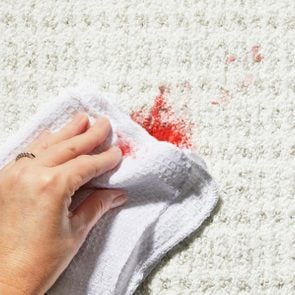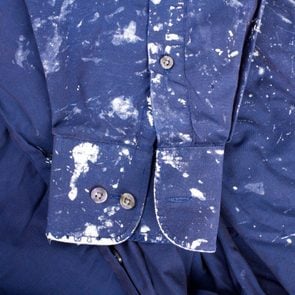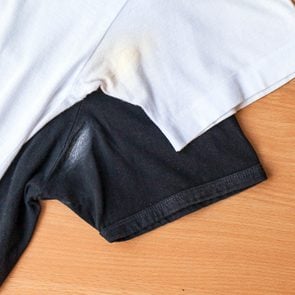How to Get Blood Out of Clothes, According to a Cleaning Pro
Updated: Apr. 03, 2024
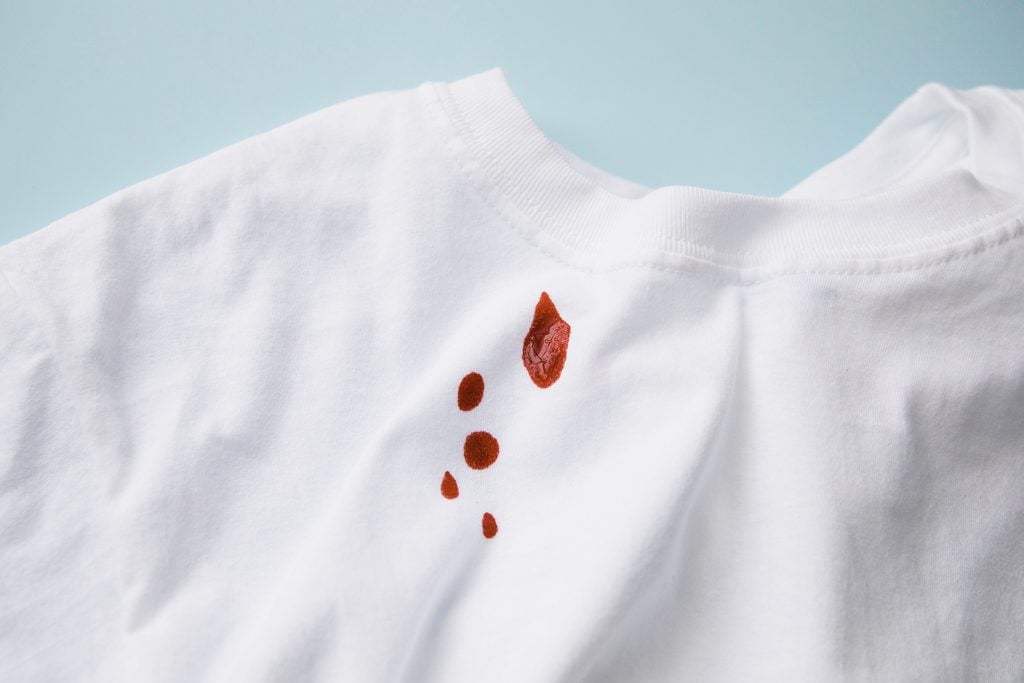
Don't let a bloodstain ruin your clothing! Take swift action and follow this expert-backed guide to effectively get fresh or dried blood out of clothes.
A bloodstain on bedsheets or your favorite pair of pants can feel like a nightmare. Trust me, I’ve been there. Nosebleeds, menstruation, cuts and scrapes leave us feeling panicked enough as it is. And to add insult to injury, we need to deal with the aftermath of the mess we’ve just made. Luckily, I’ve learned a few tricks since I began my cleaning business, including how to get blood out of clothes.
My goal is to clean, remove stains and do laundry as efficiently as I can, so I’ve researched, tested and refined my methods over nearly two decades of cleaning professionally. I’m privileged to work with appliance and detergent manufacturers to get the most up-to-date information about the industry. And that’s exactly what I am sharing with you here—with a little help from a dry cleaner pal who’s an expert on all things laundry.
Ahead, I’ll walk you through how to get blood out of clothes confidently and competently. The most valuable piece of advice I’ve gotten is to act fast, so bookmark this article so you know what to do the next time you’re faced with a bloody mess.
Get Reader’s Digest’s Read Up newsletter for more cleaning, humor, travel, tech and fun facts all week long.
About the experts
Reviewed for accuracy by: Mary Marlowe Leverette, a highly regarded fabric-care, stain-removal and housekeeping expert with more than 40 years of experience. |
On This Page
How to remove fresh bloodstains from clothing
Remember, speed is your best friend when it comes to bloodstains. The faster you act, the better your chances of banishing the blood before the stain has time to settle into the textile fibers.
The first thing you should do when a fresh bloodstain occurs is rinse the stained area with cold water—immediately. I have gotten blood right out of my clothing by doing this. Rinse until you think you’re done, then rinse for several seconds more for good measure. Hold the garment up to the light; if you can’t see an outline of the stain, you’re in good shape and can launder as usual.
If you still see some blood, it’s time to break out the stain-busting ingredients. Blood is a protein stain, so we must approach this differently than other stains. The homemade cleaner you use on oil stains, for instance, won’t get the job done. Proceed with one of the methods below.
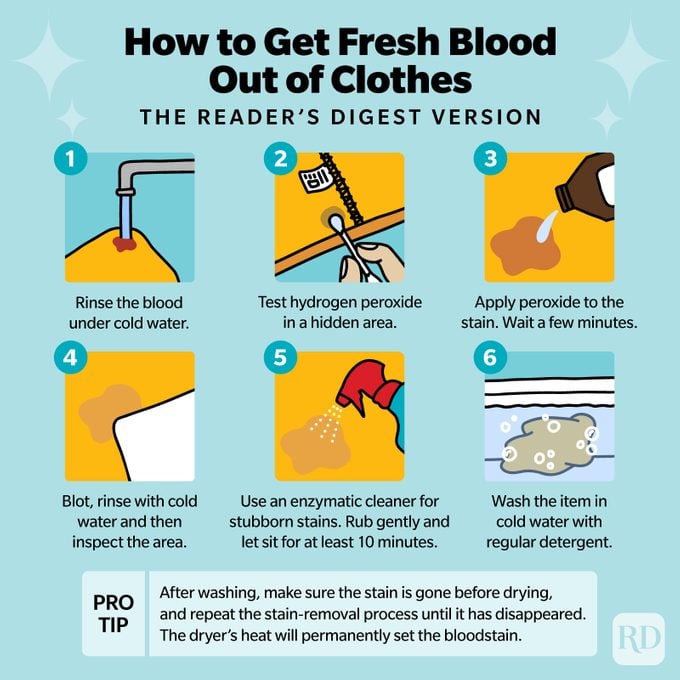
How to get blood out of clothes with hydrogen peroxide
Hydrogen peroxide acts like a powerful, fast-acting bleach, and it’s exceptional at removing bloodstains. As a bonus, it’s both inexpensive and easy to find—look for the brown bottle at your local pharmacy; the 3% solution is all you need.
To get started, follow the steps below. This approach will work for nearly every type of fabric in any color (yes, even darks).
Supplies you’ll need:
- Hydrogen peroxide
- Cotton swab (optional)
- Clean rag or cloth
Step 1: Test on an inconspicuous area
Before you jump right in, do a spot test to make sure the hydrogen peroxide won’t damage or stain your garment. A 3% peroxide solution shouldn’t bleach colored items, but it’s a smart idea to use a cotton swab to swipe a bit of peroxide onto the fabric in an inconspicuous area (like an inside seam or the hem) to be sure. As long as color doesn’t transfer to the cotton, you’re good to go.
Step 2: Cover the stain in peroxide
Apply hydrogen peroxide to the stained area, using just enough to cover the stain. I usually use the cap of the bottle to dose and pour the peroxide over the stain until it is covered.
When you pour on the peroxide, you may notice some bubbling. This is the hydrogen peroxide working to lift the stain out, break it down and bring it to the surface. Allow it to bubble for a few moments.
Step 3: Pat and rinse
Pat the area with the cloth to remove what you can and then run the item under cold water. This rinse will help remove remnants of the stain.
Step 4: Check your work
Hold the stained area up to the light to see if the stain has been lifted. If it has, amazing! You can jump to step five.
If the stain remains, however, it’s time to try an enzymatic stain fighter. Proceed to the next section and follow the steps there.
Step 5: Wash your clothes
Launder your garment in cold water with regular detergent.
Step 6: Inspect your just-washed clothes
Before putting your formerly stained garment into the dryer, check to ensure the stain has truly disappeared. The dryer’s heat can set stains, so this is crucial!
Hold the item up to the light and look for the outline of the stain. If the garment is free of stains, go ahead and toss it into the dryer. If you can still see the bloodstain, even faintly, follow the steps below to use an enzyme-based stain remover to make that blood disappear.
How to get blood out of clothes with an enzymatic cleaner
Enzyme-based stain removers are invaluable tools in your laundry arsenal because they are designed with enzymes that digest stains. These proteins go on a search-and-attack mission when applied to a stain, obliterating it from your clothing.
Just make sure you’re using the right type of stain remover with the right type of enzymes—certain enzymes are designed to remove certain types of stains. A broad-coverage product is a good choice. I like Puracy Stain Remover, which has six different enzymes, one of which is designed to tackle bloodstains.
Enzymatic cleaners are safe for nearly all fabrics and colors—but not dry-clean-only items—which cuts down on the number of cleaning products you need to stash away for a rainy (er, bloody) day. I apply my enzyme-based cleaner as soon as I see the stain and after I’ve rinsed it under cold water. Even for moderately fresh stains that have started to dry, enzymatic stain removers are excellent. And if you’ve tried using hydrogen peroxide but still see a bit of the bloodstain, following with an enzyme-based cleaner can finish the job.
Supplies you’ll need:
- Clean rag or paper towel
- Enzymatic stain remover
- Small cleaning toothbrush
Step 1: Blot and rinse
Blot up as much of the stain as you can with a paper towel or clean rag. Rinse the stain under cold water too; the more blood that you can get rid of, the better.
Step 2: Spray on a stain remover
Spray an enzymatic stain remover onto the affected area. Use a toothbrush to gently agitate the fibers and allow the product to penetrate.
Step 3: Let it sit
The stain fighter can sit on your garment for several days, but it should be wet for a minimum of 10 minutes before laundering. This gives the product time to digest the stain.
Step 4: Wash your clothes
Launder as usual, using cold water and regular detergent.
Step 5: Inspect your just-washed clothes
When the wash cycle is over, fish your stained item out of the machine—but don’t toss it into the dryer just yet. First, hold the stained area up to the light to see if you’ve successfully removed the stain. If you have, you can proceed with drying it. If not, repeat steps two and three. Dry with heat only when the stain is gone.
How to get blood out of clothes with spit (really!)
Admittedly, this is a bit odd, but it’s a pro cleaning tip worth sharing. And it might come in handy when you’re on the go. If you don’t have hydrogen peroxide or an enzymatic cleaner and need to remove a fresh bloodstain in a pinch, you can use your very own enzymes: your saliva!
Rinse the stain well with cold water, blot it dry and then spit on the stain. Use your finger to penetrate the fibers and allow your spit to break down the blood. While it’s not the classiest method of stain removal, I can say from personal experience it has helped.
How to remove dried bloodstains from clothing
Getting dried blood out of your clothes can lead to a roller coaster of emotions, from initial anger and frustration to hope and the surprised delight of a successful stain-removal process. That, or the searing disappointment of a bloodstain that won’t quit.
I want to be clear: You may not be able to remove an old bloodstain or one that’s been exposed to the heat of a washing machine or dryer. (That’s why it pays to tackle bloodstains immediately. Treating stained items isn’t an item on your weekly cleaning schedule; it’s a pressing matter.)
I’ve been on this roller coaster many times, and the most important thing I’ve learned is that when you see a dried bloodstain, you need a different approach: oxygen bleach.
Supplies you’ll need:
- Oxygen bleach powder
- Basin, bucket or tub large enough to accommodate the stained item
Step 1: Add oxygen bleach to a basin
Measure out the correct amount of your preferred oxygen bleach powder (OxiClean Versatile Stain Remover is a good choice). First, consider how much water you’ll need to fully immerse your garment. Then look to the product label; it’ll dictate how much oxygen bleach to use for a given amount of water, such as a gallon. Pour the powder into the basin you’ll be using.
Step 2: Add hot water
Pour water into the basin. It needs to be hot enough to dissolve the powder and to cause a foaming, bubbling reaction.
Step 3: Soak your clothes
Add the garment and soak for a minimum of an hour. Remove the item and check the progress. Dried blood is a stubborn stain and can require significant soak time.
Since oxygen bleach works better in warm or hot water, consider adding more hot water and more oxygen bleach every hour or so. You can do this for eight hours—even 24 hours. Old stains take time.
Step 4: Wash your clothes
Use cold water to wash clothing items that have been stained.
Step 5: Inspect your just-washed clothes
Check to see if the stain has been removed successfully by holding it up to the light and looking for remnants of the stain. If you don’t see anything, congratulations! You can do a happy dance and dry the garment.
If the stain is still there, repeat the process. You might need to do this three to four times. And if that doesn’t work, you may be unable to remove the stain.
| ♦ Pro Tip |
| If you have an immersion water heater or a sous vide, you can use this to maintain the water temperature of the bucket (check the package instructions for the optimal temperature) for the entire soak time—eight hours onward. It’s a trick I learned from a brilliant laundry friend and confidant, Zach Pozniak, co-owner of Jeeves dry cleaner in New York City. |
FAQs
How do you get blood out of white clothes?
As with clothing of other colors, you’re most likely to get bloodstains out of white clothes by acting fast. The best method is to pre-treat with an enzyme-based cleaner to break down the bloodstain, then wash your white clothing in cold water. If any stain remains after the enzyme treatment, you can use bleach or oxygen bleach to fade it.
Can you use hot water to remove bloodstains?
You cannot use hot water to remove bloodstains. Blood is a protein, so it will fuse with the fabric as soon as you apply heat. In other words, hot water actually sets a bloodstain. The best water temperature for washing clothes with stains is cold.
Can you remove bloodstains with white vinegar?
You can use white vinegar to remove a fresh bloodstain, but there are better and more effective methods—namely, enzymatic cleaners and hydrogen peroxide. If you don’t have either of those, you can pour white vinegar over the fresh bloodstain and blot it up with a clean rag until the stain disappears, then launder as usual in cold water.
Can you remove bloodstains with Dawn dish soap?
You cannot effectively remove bloodstains with dish soap. That’s because Dawn and other dish detergents are surfactants that lift oil and grease to the surface. They may be a good option for removing oil stains from clothing, but they won’t effectively lift blood, which is a protein-based stain.
If you’ve come across recipes for DIY bloodstain removers that contain Dawn, know that they likely contain hydrogen peroxide too. And the peroxide is what’s getting the job done.
How do you get blood out of wool?
According to Woolmark, a global authority on wool, the first step to removing bloodstains from this fabric is to blot up the stain with a paper towel or clean rag. You’ll want to pad the underside of the stained garment so you don’t transfer any blood to the other side. Once done, dab white vinegar over the stain to remove and lift the blood. Follow by dabbing with water, and then wash your wool items using a gentle detergent and cold water.
How do you get blood out of silk?
Silk is an extremely delicate material and can degrade if exposed to many of the recommended products above. Begin by thoroughly (and immediately) flushing the stained area with cold water. If the stain persists, treat it with an enzyme-based stain remover like Puracy Stain Remover, and allow it to sit for 30 minutes or so.
Wash your silk item in cold water on the delicate or hand-wash setting with appropriate detergent. Do not dry until you’re certain the stain is gone. Repeat as needed.
Why trust us
At Reader’s Digest, we’re committed to producing high-quality content by writers with expertise and experience in their field in consultation with relevant, qualified experts. For this piece, Melissa Maker, the cleaning expert behind the popular website and YouTube channel Clean My Space and the founder of a Toronto-based cleaning company, tapped her experience as a cleaning expert. Then Mary Marlowe Leverette, a highly regarded fabric-care, stain-removal and housekeeping expert with more than 40 years of experience, gave it a rigorous review to ensure that all information is accurate and offers the best possible advice to readers. We relied on reputable primary sources, including a dry-cleaning expert and professional organizations, as well as our writer’s personal experience. We verified all facts and data and backed them with credible sourcing, and we will revisit them over time to ensure they remain accurate and up to date. Read more about our team, our contributors and our editorial policies.
Sources:
- Zach Pozniak, professional dry cleaner and co-owner of Jeeves New York who shares his clothing-care advice on YouTube, TikTok and Instagram
- Woolmark: “The best way to remove stains from wool clothes”


